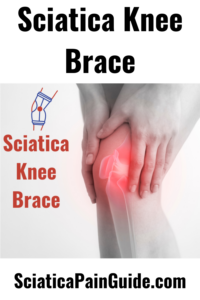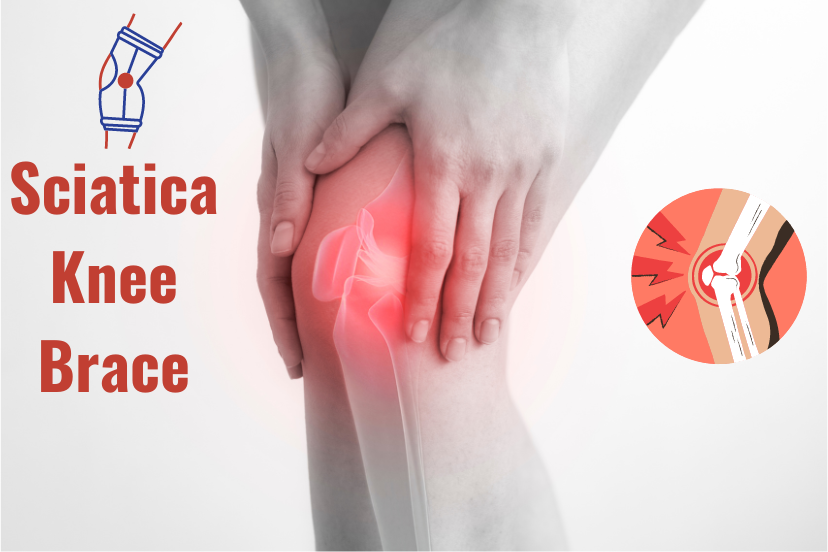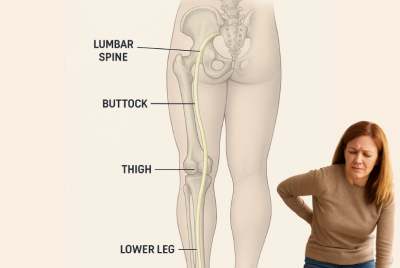Sciatica Knee Brace: Benefits, Best Options, and How to Use Them
Explore the transformative benefits of a sciatica knee brace! Dive into how it alleviates pain, supports your knee, and improves mobility. Learn how the right knee brace can offer crucial support, reduce nerve compression, and enhance your daily life. Your guide to making an informed choice is just here. Living with sciatica can be a painful and debilitating experience. However, solutions are available to help manage the symptoms and improve your quality of life. One such solution is the sciatica knee brace. A sciatica knee brace is a supportive device designed to alleviate pressure on the sciatic nerve, providing pain relief and enhancing mobility. It offers stability to the knee joint, reduces strain on the lower back, and promotes proper body alignment. By offloading pressure from the affected areas, the knee brace can help you regain your freedom of movement and engage in daily activities with less discomfort.
This article will explore the role of sciatica knee braces, how to choose the right one and the benefits of using them effectively. We will also provide valuable reasons for considering this supportive option.
Understanding Sciatica
Sciatica is pain from your lower back through your hips, buttocks, and down each leg. Typically, only one side of your body experiences this discomfort. Herniated discs, spinal stenosis, or pinched nerves usually cause it.
What Is Sciatica?
Sciatica refers to the pain that radiates along the path of the sciatic nerve, which runs from the lower back, through the hips and buttocks, down to the legs. It is often caused by the compression or irritation of the sciatic nerve, leading to discomfort, numbness, tingling sensations, and muscle weakness.
Causes Of Sciatica
Sciatica can be caused by various factors that result in the compression or irritation of the sciatic nerve. One common cause is a herniated disc, where the cushioning discs between the vertebrae of the spine protrude and press against the nerve. Another cause is spinal stenosis, which is the narrowing of the spinal canal, leading to the pinching of the nerve. Additionally, conditions such as degenerative disc disease, spondylolisthesis (slippage of vertebrae), muscle spasms, and even pregnancy can contribute to sciatica. In some cases, trauma or injury to the lower back or buttocks area can also lead to sciatic nerve compression. Understanding the underlying cause of sciatica is crucial in determining the appropriate treatment and management strategies.
Symptoms Of Sciatica
Common sciatica symptoms include sharp or shooting pain in the lower back, buttocks, and legs. The pain may worsen when sitting, standing, or walking for prolonged periods. Other symptoms may include numbness, tingling, or a burning sensation along the nerve pathway.
Sciatica is characterized by a range of symptoms that typically affect one side of the body. The most common symptom is a sharp, shooting pain that radiates from the lower back through the buttocks and down the leg along the path of the sciatic nerve. This pain can be intense and debilitating, often worsened by movements such as sitting, standing, or walking. Other symptoms include numbness or tingling sensations in the affected leg or foot, a burning or electric-like sensation, muscle weakness, and difficulty in controlling leg movements. Some individuals may also experience lower back pain or pain in the buttocks region. It’s important to note that the severity and combination of symptoms can vary from person to person, and seeking medical evaluation is crucial for an accurate diagnosis and appropriate treatment.
Will A Knee Brace Help With Sciatica Pain?
Yes, a knee brace can help with sciatica pain by providing support and stability to the knee joint. Sciatica pain often radiates down the leg due to compression or irritation of the sciatic nerve. By wearing a knee brace, it helps offload pressure from the lower back and hips, reducing strain on the sciatic nerve. The brace can also promote proper body alignment, which further alleviates pain and discomfort associated with sciatica. Additionally, the compression provided by the knee brace can improve blood circulation and reduce inflammation in the affected area, contributing to pain relief. It’s important to choose the right type of knee brace and consult with a healthcare professional for personalized advice on managing sciatica pain effectively.
The Role Of Knee Braces
Knee braces stabilize and support the knee joint to prevent injury or aid recovery. They distribute stress away from damaged areas, compress to reduce swelling and improve proprioception. Athletes, people with arthritis, or those recovering from surgery often use them for relief and protection.
How Can A Knee Brace Help Sciatica
Knee braces provide valuable support and stability to the knee joint, but their benefits extend beyond that. When dealing with sciatica, knee braces can help alleviate the pain and discomfort by offloading pressure from the lower back and hips. They can also improve posture and enhance overall body alignment, reducing the strain on the sciatic nerve.
Types Of Knee Braces
There are various types of knee braces available for individuals with sciatica. One common option is a hinged knee brace, which offers stability and protects the knee joint. Another type is a patellar stabilizing brace, designed to provide additional support to the patella. It’s important to consult with a healthcare professional to determine the most suitable knee brace for your specific condition.
Knee Brace Sciatica
Choosing The Right Knee Brace For Sciatica
Choosing the right knee brace for sciatica involves consulting a healthcare provider for an accurate diagnosis and personalized advice. Look for a brace that offers adequate support without limiting mobility. The right fit and design can help alleviate pain and improve knee alignment.
Assessing Your Needs
Before purchasing a sciatica knee brace, it’s essential to assess your needs. Consider the severity of your symptoms, the activities you engage in, and any specific requirements you may have. Understanding your needs will help you select a knee brace that offers optimal support and comfort.
Considering Comfort And Fit
When choosing a knee brace, comfort and fit are crucial. Look for braces made from breathable materials that provide a snug yet comfortable fit. Adjustable straps and closures can allow for a personalized fit, ensuring the brace stays securely in place while offering the necessary support.
Seeking Professional Advice
To make an informed decision, it’s advisable to consult with a healthcare professional or an orthopedic specialist. They can assess your condition, recommend the appropriate knee brace, and provide guidance on its usage. Professional advice will ensure you choose the right knee brace for your specific needs.
Benefits Of Using A Sciatica Knee Brace
A knee brace for sciatica nerve pain can offer several benefits, including improved knee stability and alignment. These changes may reduce nerve compression responsible for sciatic pain. A knee brace also provides added support during physical activity, potentially preventing further injury. Consult a healthcare provider for optimal results.
Pain Relief And Support
One of the significant benefits of using a sciatica knee brace is the pain relief it provides. The brace’s compression and support help reduce pressure on the sciatic nerve, easing discomfort and promoting better mobility. By stabilizing the knee joint, the sciatic knee brace helps alleviate strain on the lower back, offering relief from sciatic pain.
Enhanced Mobility
Sciatica can restrict mobility, making everyday activities challenging. A well-fitted knee brace can enhance your mobility by providing stability to the knee joint. With improved mobility, you can perform tasks more comfortably and enjoy a better quality of life.
Promoting Healing And Recovery
Using a sciatica knee brace not only alleviates pain but also aids in the healing and recovery process. By reducing stress on the sciatic nerve and the surrounding muscles, the brace allows your body to heal naturally. It provides gentle compression and support, promoting better blood circulation and facilitating the recovery of injured tissues.
Using a Sciatica Knee Brace Effectively
A sciatica knee brace supports the knee and can alleviate sciatic nerve pain by improving posture and alignment. Wearing it stabilizes the knee and adjacent muscles, potentially reducing nerve compression. Consult a healthcare provider for proper fit and usage to maximize effectiveness.
Wearing And Adjusting
When using a sciatica knee brace, it’s important to wear it correctly and make necessary adjustments. Follow the manufacturer’s instructions to ensure proper placement and fit. Regularly check the brace for any signs of wear or damage, and readjust it as needed for optimal support and effectiveness.
Complementing With Exercises
While a knee brace can provide significant relief, it’s essential to complement its usage with targeted exercises. Consult with a physical therapist or a healthcare professional to develop an exercise routine that strengthens the muscles supporting the knee and promotes spinal health. Exercises such as stretching, core strengthening, and low-impact aerobics can contribute to long-term sciatica management.
Taking Care Of Your Knee Brace
Proper care is necessary to maximize the lifespan and effectiveness of your sciatica knee brace. Follow the manufacturer’s guidelines for cleaning and maintenance. Keep the brace dry and store it in a cool, well-ventilated place when not in use. Regularly inspect the brace for any signs of wear and tear, and replace it if needed.
How To Wear Sciatica Knee Brace?
When wearing a sciatica knee brace, it’s important to follow proper guidelines for optimal effectiveness:
- Ensure a proper fit: Adjust the straps and closures to achieve a snug yet comfortable fit around your knee. The brace should provide support without being too tight or restrictive.
- Positioning: Place the knee brace on the affected leg, aligning it with the center of your knee joint. Make sure the patellar opening is correctly positioned over your kneecap.
- Secure the brace: Fasten the straps or closures according to the manufacturer’s instructions. Ensure the brace is securely in place without cutting off circulation or causing discomfort.
- Comfort and mobility: Move around to ensure the brace doesn’t restrict your movement or cause discomfort. It should provide support while allowing for natural mobility.
- Check for proper alignment: Periodically check that the knee brace is properly aligned and hasn’t shifted out of position during use.
Remember to consult with a healthcare professional for specific instructions on wearing and adjusting your sciatica knee brace, as they can provide personalized advice based on your condition and needs.
What Is The Best Sciatica Knee Brace?
Determining the best sciatica knee brace depends on various factors, including the severity of your symptoms and your specific needs. Some popular options include hinged knee braces, which offer stability and protection to the knee joint, and patellar stabilizing braces, designed to provide additional support to the patella. The best sciatica knee brace for you should offer a snug yet comfortable fit, be made from breathable materials, and have adjustable straps for a personalized fit. It’s essential to consult with a healthcare professional or an orthopedic specialist who can assess your condition and recommend the most suitable knee brace based on your individual needs. Their expertise will ensure you choose a brace that provides optimal support and pain relief for managing your sciatica effectively.
Alternative To Sciatica Knee Brace

While a sciatica knee brace can help manage symptoms, there are alternative approaches you can consider:
Physical Therapy
Working with a physical therapist can help improve flexibility, strengthen muscles, and correct posture to alleviate sciatica pain. Physical therapy uses targeted exercises and hands-on techniques to improve mobility, relieve pain, and restore bodily function. Trained therapists assess patients and develop customized treatment plans. Effective for conditions like arthritis, post-surgical recovery, or sports injuries, it often reduces the need for medication or surgery.
Exercise And Stretching
Engaging in low-impact exercises like swimming or walking and performing specific stretches targeting the lower back and hips can provide relief. Exercise and stretching play vital roles in maintaining physical health and well-being. Exercise boosts cardiovascular health, builds muscle, and enhances endurance. Stretching improves flexibility and range of motion and can also relieve muscle tension. Both are crucial for injury prevention and overall physical performance.
Medications
Over-the-counter pain relievers or prescribed medications, such as muscle relaxants or anti-inflammatories, may help reduce sciatica pain temporarily. Medications treat, prevent, or manage illnesses and medical conditions. Doctors prescribe them based on a patient’s specific needs. Antibiotics fight bacterial infections, pain relievers alleviate discomfort, and antihypertensives lower blood pressure. Always consult healthcare providers for proper diagnosis and medication guidance.
Heat Or Cold Therapy
Applying heat or cold packs to the affected area can help alleviate pain and reduce inflammation. Heat therapy relaxes muscles, improves blood flow, and is often used for chronic pain or stiffness. Cold therapy reduces inflammation and numbs the area, usually applied for acute injuries or swelling. Knowing when to use heat or cold can significantly impact the healing process.
Epidural Steroid Injections
In severe cases, a healthcare professional may recommend injections of steroids directly into the affected area to reduce inflammation and alleviate pain.
It’s important to consult with a healthcare professional to determine the most appropriate alternative treatment options for your specific condition and symptoms.
Frequently Asked Questions (FAQs)
Can a knee brace cure sciatica?
While a knee brace cannot cure sciatica, it can help manage the symptoms and relieve pain by offloading pressure from the sciatic nerve.
How long should I wear a sciatica knee brace?
The duration of wearing a knee brace depends on your specific condition and the advice of your healthcare professional. They will provide guidelines on when and how long to wear the brace for optimal results.
How do you fix knee pain with sciatica?
To alleviate knee pain associated with sciatica, consult a healthcare provider for a diagnosis and treatment plan. Physical therapy, medication, and sometimes knee braces can offer relief.
Is leg compression good for sciatica pain?
Leg compression may temporarily relieve sciatica pain by improving blood flow and reducing muscle tension. However, it’s not a definitive treatment for the underlying issue. Consult a healthcare provider for a proper diagnosis and comprehensive treatment plan.
Are knee braces uncomfortable to wear?
When properly fitted, knee braces should provide support and comfort. Look for braces made from breathable materials and consider adjustable features for a personalized fit.
Extra FAQs Related To Sciatica Knee Brace
Can I exercise while wearing a sciatica knee brace?
In most cases, you can exercise while wearing a knee brace. However, it’s essential to consult with a healthcare professional or physical therapist to ensure you’re performing the right exercises and using the brace effectively.
Does knee brace help sciatica?
A knee brace may relieve sciatica by stabilizing the knee and improving alignment. This support could reduce nerve compression, although it’s not a definitive cure. Consult a healthcare provider for personalized advice and proper fitting.
Can a knee brace be used as a long-term solution for sciatica?
Knee braces can be used as part of a comprehensive sciatica management plan. While they provide immediate relief, it’s essential to address the underlying causes and consider other treatment options for long-term relief.
Sciatica Knee Brace – Conclusion
If you’re dealing with sciatica, a knee brace can be valuable in managing your symptoms and improving your overall well-being. By providing support, stability, and pain relief, a sciatica knee brace allows you to regain mobility and enjoy a more comfortable life. Remember to assess your needs, consult with professionals, and use the knee brace effectively to maximize its benefits.
Disclaimer
Please note that the information provided in this article is for informational purposes only and should not replace professional medical advice. If you’re experiencing sciatica pain or any health concerns, it’s advisable to consult a healthcare professional for proper diagnosis and treatment.
👉 Explore more:





